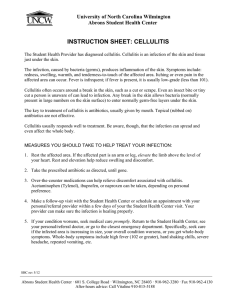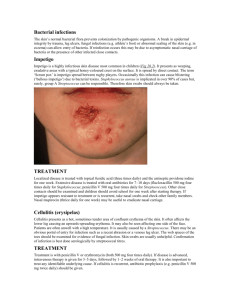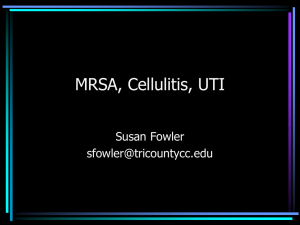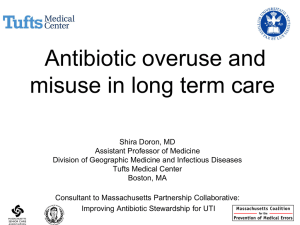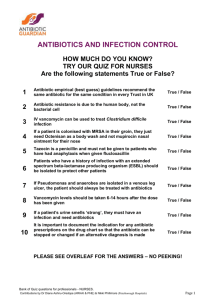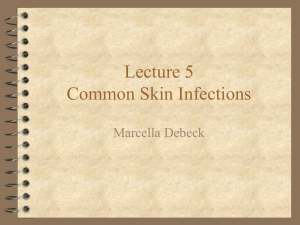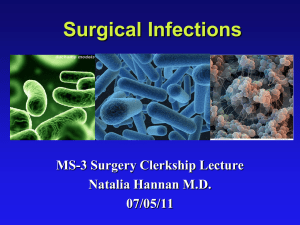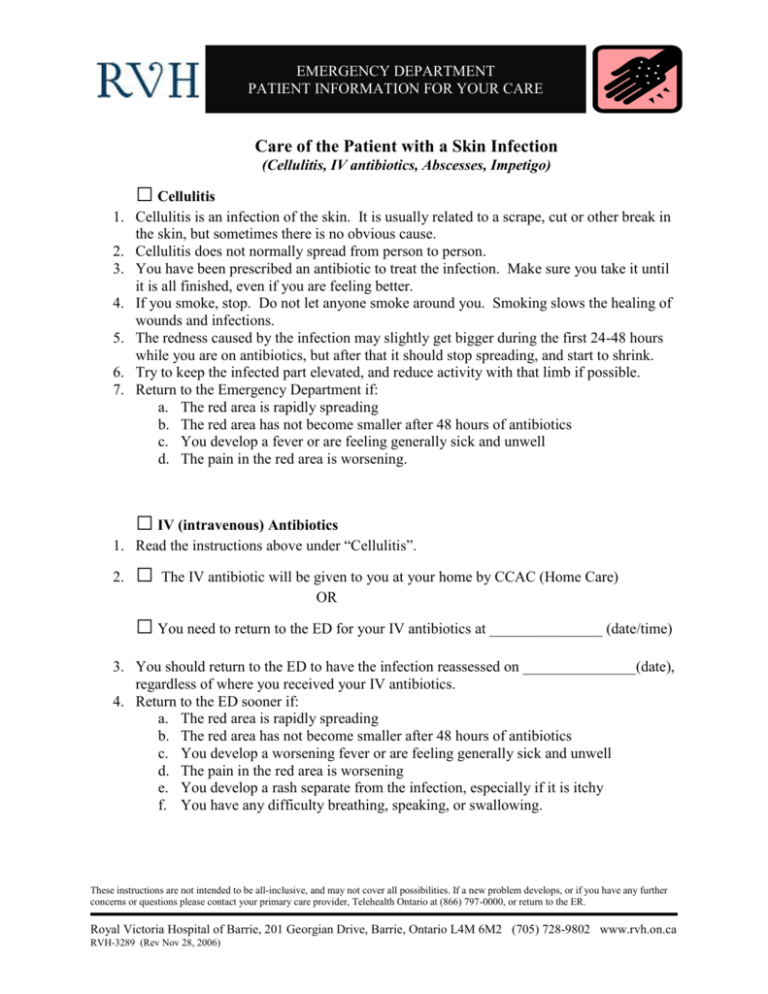
EMERGENCY DEPARTMENT
PATIENT INFORMATION FOR YOUR CARE
Care of the Patient with a Skin Infection
(Cellulitis, IV antibiotics, Abscesses, Impetigo)
□ Cellulitis
1. Cellulitis is an infection of the skin. It is usually related to a scrape, cut or other break in
the skin, but sometimes there is no obvious cause.
2. Cellulitis does not normally spread from person to person.
3. You have been prescribed an antibiotic to treat the infection. Make sure you take it until
it is all finished, even if you are feeling better.
4. If you smoke, stop. Do not let anyone smoke around you. Smoking slows the healing of
wounds and infections.
5. The redness caused by the infection may slightly get bigger during the first 24-48 hours
while you are on antibiotics, but after that it should stop spreading, and start to shrink.
6. Try to keep the infected part elevated, and reduce activity with that limb if possible.
7. Return to the Emergency Department if:
a. The red area is rapidly spreading
b. The red area has not become smaller after 48 hours of antibiotics
c. You develop a fever or are feeling generally sick and unwell
d. The pain in the red area is worsening.
□ IV (intravenous) Antibiotics
1. Read the instructions above under “Cellulitis”.
2.
□ The IV antibiotic will be given to you at your home by CCAC (Home Care)
OR b
□ You need to return to the ED for your IV antibiotics at _______________ (date/time)
3. You should return to the ED to have the infection reassessed on _______________(date),
regardless of where you received your IV antibiotics.
4. Return to the ED sooner if:
a. The red area is rapidly spreading
b. The red area has not become smaller after 48 hours of antibiotics
c. You develop a worsening fever or are feeling generally sick and unwell
d. The pain in the red area is worsening
e. You develop a rash separate from the infection, especially if it is itchy
f. You have any difficulty breathing, speaking, or swallowing.
These instructions are not intended to be all-inclusive, and may not cover all possibilities. If a new problem develops, or if you have any further
concerns or questions please contact your primary care provider, Telehealth Ontario at (866) 797-0000, or return to the ER.
Royal Victoria Hospital of Barrie, 201 Georgian Drive, Barrie, Ontario L4M 6M2 (705) 728-9802 www.rvh.on.ca
RVH-3289 (Rev Nov 28, 2006)
EMERGENCY DEPARTMENT
PATIENT INFORMATION FOR YOUR CARE
□ Skin Abscesses or Infected Cysts
1. A skin abscess or infected cyst is a skin infection that has formed a pocket, or lump of
infected fluid.
2. Depending on the stage of infection, these lumps may be opened and drained, a procedure
called “Incision and Drainage” (I&D).
3. Soak the affected area 3 to 4 times a day in hot water, or using a hot compress. You may
add Epsom salts to the water.
4. Try to keep the affected area elevated and rested as much as possible.
5. If you had an I&D performed:
a. You may remove the packing gauze in 24 hours time.
b. If this is to be replaced, your doctor has made arrangements to have it done at
_________________(location) on ____________ (date)
c. The point of packing and soaking is to keep the wound open long enough to allow
the infection to drain out. If the wound closes too soon, the infection may
reoccur.
d. You will probably have a scar at the site of the I&D. The wound will take 1-2
weeks to heal.
6. Return to the ED if:
a. The red area is rapidly spreading
b. The red area has not become smaller after 48 hours of soaking
c. The I&D wound closes and the abscess seems to have come back
d. You develop a fever or are feeling generally sick and unwell.
□ Impetigo
1. Impetigo is an infection of the superficial layers of the skin that usually is seen on the
face in children, but can occur at any age and anywhere on the body.
2. The infection causes small blisters to form on the skin, which pop and leak a yellowish
fluid. The fluid dries and forms a crust.
3. Impetigo is contagious. It is spread by contact with the crust or yellowish fluid from the
infection. The patient should not share bedsheets, towels, or clothes with other people.
4. Impetigo is usually treated with an antibiotic, which may be an ointment or pills. If you
were prescribed pills, make sure to take them as directed until they are all gone, even if
you are feeling better.
5. Gently cleanse the skin lesions 2-3 times daily with soap and water. You may use a
clean, soft washcloth to help remove the crusts. Make sure the cloths are cleaned
between uses.
6. After the crusts are removed apply the antibiotic ointment, if you were given one.
7. Make sure you (and the patient) wash your hands carefully after every time you touch the
sores.
8. See your primary care provider or return to the ED if the rash is spreading despite
treatment.
These instructions are not intended to be all-inclusive, and may not cover all possibilities. If a new problem develops, or if you have any further
concerns or questions please contact your primary care provider, Telehealth Ontario at (866) 797-0000, or return to the ER.
Royal Victoria Hospital of Barrie, 201 Georgian Drive, Barrie, Ontario L4M 6M2 (705) 728-9802 www.rvh.on.ca
RVH-3289 (Rev Nov 28, 2006)

